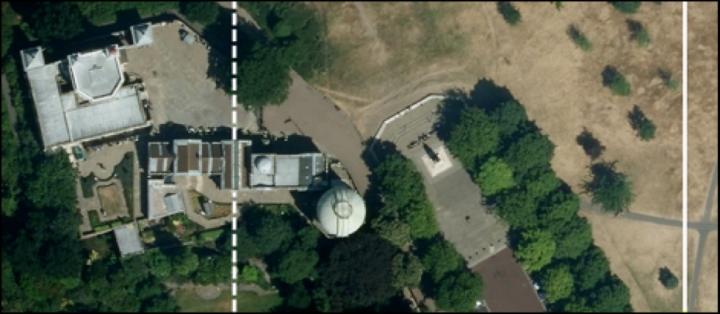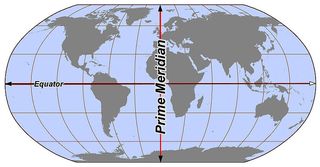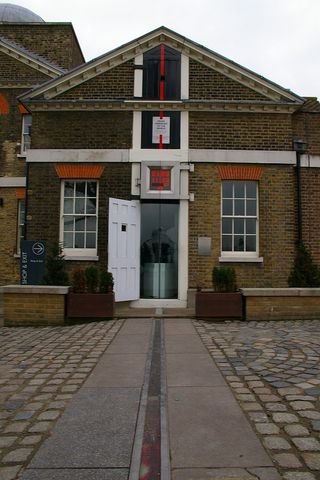Moving the Earth's Prime Meridian

Tourists who want to take photographs at the prime meridian often stand at the Royal Observatory in Greenwich, England. But improved technology reveals that the actual site of the imaginary north-south line that cuts the Earth in half at zero degrees longitude lies 334 feet (102 meters) east of the historical marker. The increased accuracy means that many historical coordinates are sometimes off by significant distances.
"Most people stand on the stripe and have their picture taken, with the sundial in the background," said Ken Seidelmann, an astronomer at the University of Virginia. "If they stood there with their GPS receiver, it wasn't zero degrees." [Photos: Amazing Images of Earth from Space]
Seidelmann learned that many people reported that their GPS devices listed the line of zero degrees longitude in a completely different location than at the landmark. He was part of a team of scientists who found that the prime meridian had shifted because of improved measurements rather than changes in the Earth's surface. Seidelmann presented the results at the American Astronomical Society's Division on Dynamical Astronomy in Nashville, Tennessee, in May.

GPS trumps the stars
In 1675, when England's Royal Observatory was founded, Earth was thought to be perfectly spherical. Later observations revealed that the planet, like most others, has a slight bulge around its center, which affects how gravity tugs at things across the globe. In 1884, the observatory's Airy Transit Circle, an instrument that measures star positions and determines local time, was set at what was then considered the calculated location of the prime meridian, and that's where most photographs are taken today.
To officially set the line of longitude, scientists relied on an instrument known as a photographic zenith tube, a telescope using the reflection of light off of mercury to determine the imaginary vertical line running toward Earth's core. But Earth's crust isn't perfectly flat; mountains and other terrain, along with the central bulge, affect the pull of gravity and distort calculations of the tug from the center of the Earth. The prime meridian, which sets the boundaries for time zones and the baseline for other lines of longitude around the globe, suffered from these variations.
Rather than using a basin of mercury, modern technology relies on precise measurements of the line running from the crust to the center of the Earth. To make those measurements, modern scientists incorporate variations in Earth's rotation, atomic clocks, lasers bounced from Earth to the moon and back, and GPS satellites.
"Better technology came along and phased out the optical methods," Seidelmann said.
Get the Space.com Newsletter
Breaking space news, the latest updates on rocket launches, skywatching events and more!
In 1984, the International Time Bureau (BIH) redefined the location of the prime meridian based on refined measurements of the Earth's center. Thanks to satellites, the location of Earth's center of mass has been measured with an accuracy of about the size of a dime; in 1984, the accuracy was slightly less precise. Faced with the decision of whether to shift the longitudes of the Earth or its time zones to match modern measurements, the BHI chose to have its newly applied system shift the map rather than the time zones.
"They chose not to have a discontinuity in time and let the longitudes correct themselves," Seidelmann said.
Seidelmann's research was published in the Journal of Geodesy.

Disappearing telescopes
After determining why the prime meridian had shifted, Seidelmann and his colleagues investigated how longitudes around the world were affected by the change. After determining the locations of observatories in a variety of nations, as described in historical references, they sent colleagues around the world out to determine whether the longitudes of the antique instruments were all off by 334 feet.
That task wound up being more challenging than it first appeared. According to Seidelmann, most of the instruments had disappeared, and the people who once used them were either retired or dead.
"You're sending people out to try to find an instrument that doesn't exist," he said.
Finding instruments in eastern European countries that were once part of the Soviet Union was particularly challenging. In many cases, they found that observatories of the now-defunct country reported false locations of their instruments. In another memorable case, one Canadian instrument was reportedly located at its Ottawa, Ontario, observatory when in fact it sat on a local farm; its foundation was all that remained, he said.
In every place, the researchers found that the longitudes provided were off by some degree.
"In a number of places, they were off by one heck of a lot," Seidelmann said.
Follow Nola Taylor Redd on Twitter @NolaTRedd or Google+. Follow us at @Spacedotcom, Facebook or Google+. Originally published on Space.com.
Join our Space Forums to keep talking space on the latest missions, night sky and more! And if you have a news tip, correction or comment, let us know at: community@space.com.

Nola Taylor Tillman is a contributing writer for Space.com. She loves all things space and astronomy-related, and enjoys the opportunity to learn more. She has a Bachelor’s degree in English and Astrophysics from Agnes Scott college and served as an intern at Sky & Telescope magazine. In her free time, she homeschools her four children. Follow her on Twitter at @NolaTRedd